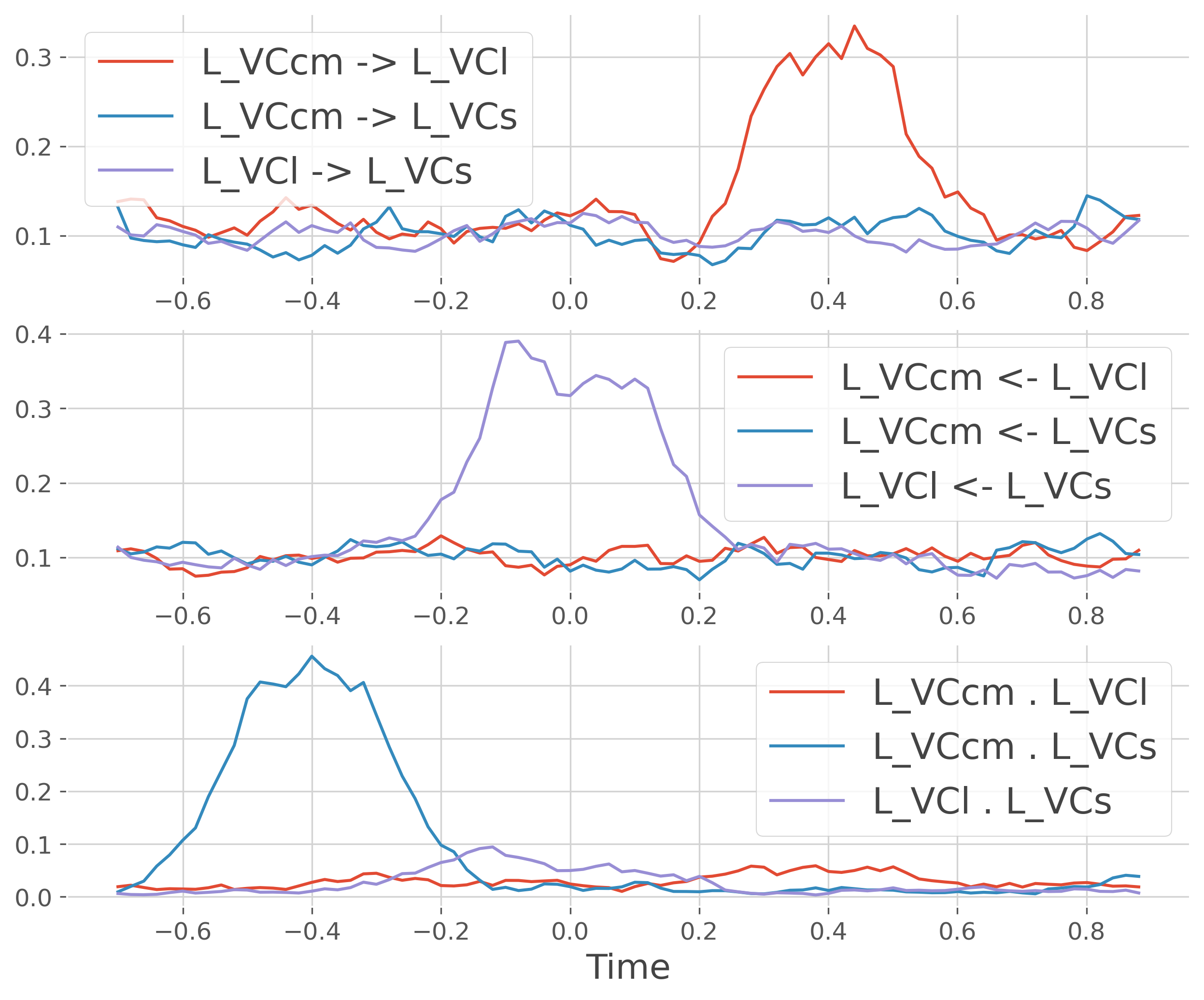Note
Go to the end to download the full example code.
Estimate the covariance-based Granger Causality#
This example illustrates how to compute single-trial covariance-based Granger Causality.
import numpy as np
from itertools import product
from frites.simulations import sim_single_suj_ephy
from frites.conn import (conn_covgc, conn_reshape_directed,
conn_reshape_undirected)
from frites import set_mpl_style
import matplotlib.pyplot as plt
import seaborn as sns
set_mpl_style()
Simulate electrophysiological data#
Let’s start by simulating MEG / EEG electrophysiological data coming from a single subject. The output data of this single subject has a shape of (n_epochs, n_roi, n_times)
modality = 'meeg'
n_roi = 3
n_epochs = 10
n_times = 1000
x, roi, _ = sim_single_suj_ephy(n_epochs=n_epochs, n_times=n_times,
modality=modality, n_roi=n_roi, random_state=0)
times = np.linspace(-1, 1, n_times)
Simulate spatial correlations#
Bellow, we are simulating some distant correlations by injecting the activity of an ROI to another
# instantaneous between 0 and 2 (0.2)
x[:, [2], slice(200, 400)] += x[:, [0], slice(200, 400)]
# directed flow from 2 to 1 (2->1)
x[:, [1], slice(400, 600)] += x[:, [2], slice(400, 600)]
x[:, [2], slice(399, 599)] += x[:, [2], slice(400, 600)]
# directed flow from 0 to 1 (0->1)
x[:, [0], slice(600, 800)] += x[:, [1], slice(600, 800)]
x[:, [0], slice(599, 799)] += x[:, [0], slice(600, 800)]
Compute the covgc#
The covgc is going to be computed per trials, bewteen pairs of ROI and inside each of the temporal window
t0 = np.arange(100, 900, 10)
lag = 10
dt = 100
gc = conn_covgc(x, dt, lag, t0, times=times, roi=roi, n_jobs=1)
roi_p = gc['roi'].data
0%| | : 0/3 [00:00<?, ?it/s]
33%|███▎ | : 1/3 [00:00<00:01, 1.52it/s]
67%|██████▋ | : 2/3 [00:01<00:00, 1.52it/s]
100%|██████████| : 3/3 [00:01<00:00, 1.52it/s]
100%|██████████| : 3/3 [00:01<00:00, 1.52it/s]
Below we plot the mean time series of both directed and undirected covgc
# take the mean across trials
gc = gc.mean('trials')
plt.figure(figsize=(10, 8))
plt.subplot(311)
for r in roi_p:
plt.plot(gc.times.data, gc.sel(roi=r, direction='x->y').T,
label=r.replace('-', ' -> '))
plt.legend()
plt.subplot(312)
for r in roi_p:
plt.plot(gc.times.data, gc.sel(roi=r, direction='y->x').T,
label=r.replace('-', ' <- '))
plt.legend()
plt.subplot(313)
for r in roi_p:
plt.plot(gc.times.data, gc.sel(roi=r, direction='x.y').T,
label=r.replace('-', ' . '))
plt.legend()
plt.xlabel('Time')
plt.show()

Finally, you can also plot the 2D representation of the connectivity arrays
# select instantaneous at -0.4 seconds
gc_inst = gc.copy().sel(times=-.4, method='nearest').sel(direction='x.y')
gc_2d_inst = conn_reshape_undirected(gc_inst, to_dataframe=True)
# select directed connectivity at 0. and 0.4 seconds
gc_0 = gc.copy().sel(times=0., method='nearest')
gc_2d_0 = conn_reshape_directed(gc_0, to_dataframe=True)
gc_04 = gc.copy().sel(times=0.4, method='nearest')
gc_2d_04 = conn_reshape_directed(gc_04, to_dataframe=True)
# plot the 2d connectivity arrays
plt.figure(figsize=(18, 6))
kw = dict(cmap='viridis', vmin=0., square=True)
plt.subplot(131)
sns.heatmap(gc_2d_inst, **kw)
plt.title("Instantaneous connectivity at -0.4s")
plt.subplot(132)
sns.heatmap(gc_2d_0, **kw)
plt.title("Directed connectivity at 0s")
plt.subplot(133)
sns.heatmap(gc_2d_04, **kw)
plt.title("Directed connectivity at 0.4s")
plt.tight_layout()
plt.show()

Total running time of the script: (0 minutes 4.823 seconds)
Estimated memory usage: 458 MB